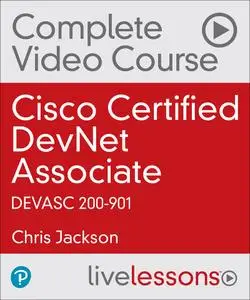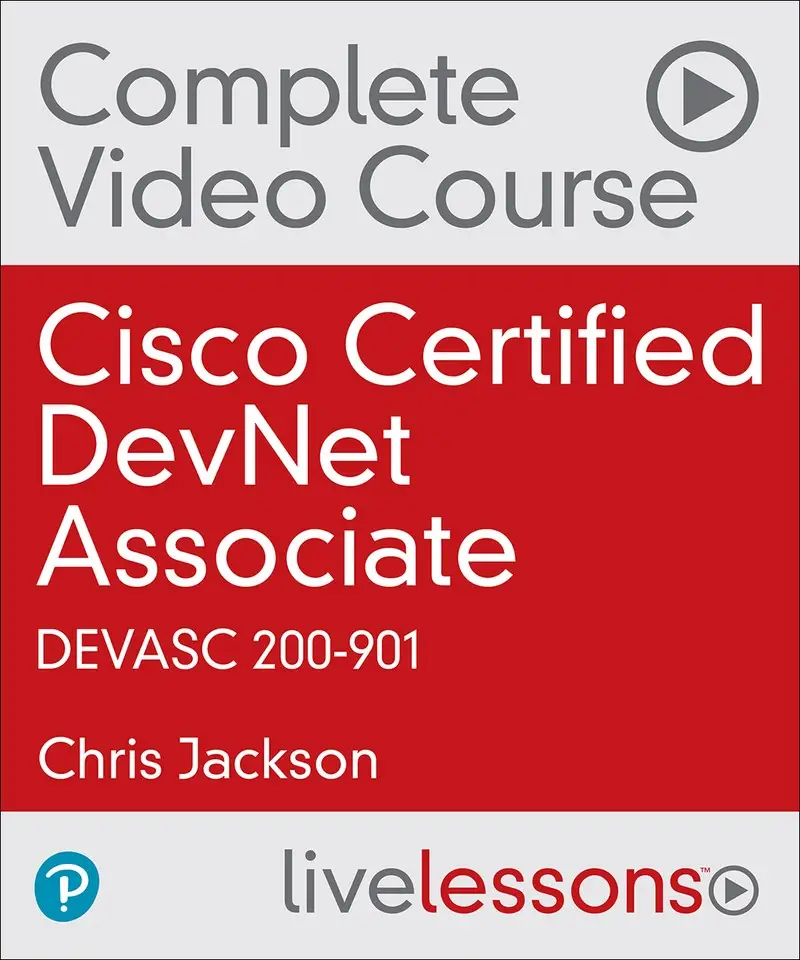Cisco Certified DevNet Associate DEVASC 200-901
English | 2021 | h264, yuv420p, 1280x720 | 44100 Hz, 2channels | Duration: 15h 19min | 25.72 GB
English | 2021 | h264, yuv420p, 1280x720 | 44100 Hz, 2channels | Duration: 15h 19min | 25.72 GB
The Cisco Certified DevNet Associate DEVASC 200-901 Complete Video Course correlates directly to the DEVASC 200-901 exam blueprint, which lays out the skills needed to operate within the current world of infrastructure automation and programmability, while also preparing them for a successful exam experience.
The Cisco Certified DevNet Associate DEVASC 200-901 Complete Video Course is designed to allow people from both a networking and programming background to jump right in. Each of the 31 lessons directly maps to the exam blueprint and covers the core technologies and concepts needed for exam success. In addition, many of the labs and demonstrations will show you simple and practical uses of infrastructure programmability techniques.
Whether you are preparing for the DEVASC 200-901 exam, or simply looking to expand your understanding of concepts and strategies for operating your infrastructure effectively in the ever-changing digital landscape, this course will provide practical tools and techniques to support your career and exam aspirations. Through theory overviews and hands-on demonstrations, Chris Jackson explains both the basics and intricacies of automation and programmability in an easy to understand way.
Topics include:
Module 1: Software Development and Design
Module 2: Python Fundamentals for DEVASC
Module 3: Understanding and Using APIs
Module 4: Application Deployment and Security
Module 5: Network Fundamentals
Module 6: Infrastructure and Automation
Module 7: Developing on Cisco Platforms
About the Instructor
Chris Jackson, CCIEx2 (RS, SEC) #6256, is a Distinguished Architect working in the Cisco Global Strategy Organization. He is also the author of Network Security Auditing (CiscoPress, 2010), CCNA Cloud CLDADM 210-455 Official Cert Guide (CiscoPress, 2016), and Cisco Certified DevNet Associate DEVASC 200-901 Official Cert Guide (CiscoPress, 2020). Chris is focused on DevOps, Security, Automation, Cloud, and helping Cisco and customers better leverage the business transformational aspects these technologies provide. He holds dual CCIEs in security and routing and switching, CISA, CISSP, ITIL v3, seven SANS certifications, and a bachelor's degree in business administration.
Skill Level
Beginner/Intermediate
Learn How To
Program Cisco infrastructure devices
Implement DevOps automation
Create a more agile and flexible IT environment
Study and prepare for DEVASC exam success
Who Should Take This Course
This course is intended for anyone wanting to achieve the Cisco DevNet Associate certification, or anyone who has IT infrastructure and would like to learn how to use emerging technologies to automate and simplify operations.
Course Requirements
Basic understanding of networking infrastructure equipment
Computer literacy, PC operating system knowledge, and Internet knowledge
Hands-on experience with the Python programming language
Lesson Descriptions
Module 1, “Software Development and Design,” introduces key software development methods, like waterfall and agile, and also discusses two common software design patterns MVC and Observer. This module will cover basic Linux BASH usage to make sure that you understand how to find your way around the terminal and the many command line tools you will need to be familiar with. Software version control systems are introduced, as well as how to use the ever-popular git version control platform. This module ends with an introduction to conducting code reviews and understanding of what Test-Driven development is and how to use it to streamline your code writing efforts.
Module 2, “Python Fundamentals for DEVASC,” provides an overview of Python from its syntax to working with variables and data types. We will also review program logic through the use of conditionals and loops to control program flow and branching logic. Next, we discuss Object-Oriented Programing and the use of techniques like classes, methods, and inheritance. We then cover the use of Python modules, as well as listing out key modules you might want to use in your programs to extend Pythons capabilities. Then, we explore Python testing with the UnitTest module. Finally, we discuss the various ways you can input data into your Python program, parse the data, and provide error handling in your code.
Module 3, “Understanding and Using APIs,” begins with understanding what an API is and the common way APIs are used. Next, we cover the essentials of REST APIs, including URL construction, methods, headers, return codes, data-formats, architectural constraints, and various tools used for working with REST APIs. Lastly, you see how to make REST API calls in Python.
Module 4, “Application Deployment and Security,” defines current application deployment models and their characteristics. Then, we discuss what DevOps is as well as tools and techniques used in building continuous integration and deployment pipelines. Next, we explore Docker, how to use it, and build container-based applications. Then, we finish with understanding application security requirements and the importance of building applications with a security-focused mindset. Additionally, this module discusses the Open Web Application Security Project (OWASP)'s top ten, which is a list that highlights the ten most common security vulnerabilities that you need to combat.
Module 5, “Network Fundamentals,” presents several key networking concepts including networking reference models (OSI and TCP/IP); and foundational switching and routing concepts like Ethernet technologies, MAC addresses, VLANs, as well as IPv4 and IPv6 addressing. In addition, this module covers several protocols and technologies that are critical to networking, like DHCP, DNS, NAT, SNMP, and NTP. The module finishes with a focus on troubleshooting application connectivity issues by understanding application constraints and how to read Layer 2 and Layer 3 networking diagrams.
Module 6, “Infrastructure and Automation,” introduces the value of automation to your operational model. We then explore several infrastructure automation concepts including controller versus device-level management; infrastructure as code; continuous integration/continuous delivery pipelines; and automation tools and frameworks such as Ansible, Puppet, and Chef. Then we introduce key model-driven programmability concepts and protocols through an overview of YANG, YANG data models, NETCONF, and RESTCONF. Finally, we will explore a few Cisco-related products used in infrastructure automation such as Cisco NSO, Cisco CML, and pyATS.
Module 7, “Developing on Cisco Platforms,” starts with an overview of key software development like SDKs and how to use them to automate Cisco infrastructure platforms. Next, we discuss the Cisco Campus and Wan networking Platforms and their APIs, including examples of how to interact with the APIs and demonstrations on how they work in practical terms. We then do the same for Cisco Data Center portfolio and Cisco Compute Management Platforms and their associated APIs. The Cisco Collaboration platforms are next, and we end with the Cisco Security platforms and their associated APIs along with how to use them.



